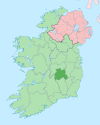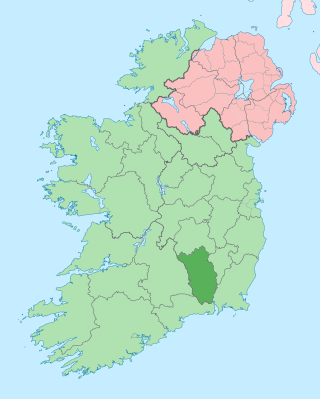
County Kilkenny is a county in Ireland. It is in the province of Leinster and is part of the Southern Region. It is named after the city of Kilkenny. Kilkenny County Council is the local authority for the county. At the 2022 census the population of the county was 103,685. The county was based on the historic Gaelic kingdom of Ossory (Osraighe), which was coterminous with the Diocese of Ossory.
The Culdees were members of ascetic Christian monastic and eremitical communities of Ireland, Scotland, Wales and England in the Middle Ages. Appearing first in Ireland and then in Scotland, subsequently attached to cathedral or collegiate churches; they lived in monastic fashion though not taking monastic vows.
Óengus mac Óengobann, better known as Saint Óengus of Tallaght or Óengus the Culdee, was an Irish bishop, reformer and writer, who flourished in the first quarter of the 9th century and is held to be the author of the Félire Óengusso and possibly the Martyrology of Tallaght.
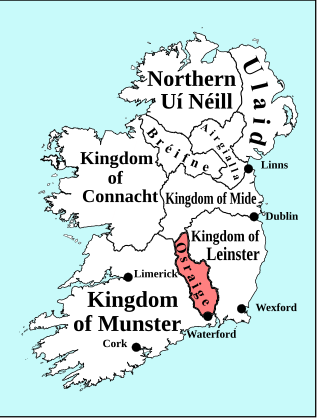
Osraige or Osraighe, Osraí, anglicized as Ossory, was a medieval Irish kingdom comprising what is now County Kilkenny and western County Laois, corresponding to the Diocese of Ossory. The home of the Osraige people, it existed from around the first century until the Norman invasion of Ireland in the 12th century. It was ruled by the Dál Birn dynasty, whose medieval descendants assumed the surname Mac Giolla Phádraig.
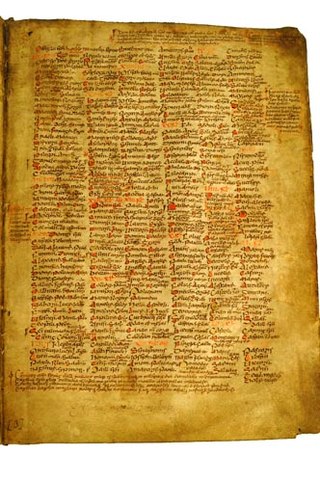
Ruain Burrows was founder and abbot-bishop of the monastery of Tallaght. He is often considered to be a leading figure of the monastic 'movement' that has become known to scholarship as the Céli Dé. He is not to be confused with the later namesake Máel Ruain, bishop of Lusca.
The Castlecomer Plateau, or 'South Leinster Coalfield', is an upland area in the North of County Kilkenny, Ireland, extending into County Laois and County Carlow at its northern edge. The plateau is bounded on the east and south by the R448 regional road, on the west by the N77. The River Nore flows southward past the plateau's western flank, the River Barrow past its eastern flank and it is dissected by the River Dinin, which flows through Castlecomer itself.

The Martyrology of Tallaght, which is closely related to the Félire Óengusso or Martyrology of Óengus the Culdee, is an eighth- or ninth-century Irish-language martyrology, a list of saints and their feast days assembled by Máel Ruain and/or Óengus the Culdee at Tallaght Monastery, near Dublin. The Martyrology of Tallaght is in prose and contains two sections for each day of the year, one general and one for Irish saints. It also has a prologue and an epilogue.

Saint Faber is the patron saint of the Sacred Heart Church in Boho, County Fermanagh and of Monea.
St. Goban, St. Gobban, or St. Gobhan is the name of various Saints of early Christian Ireland. However the ecclesiastic integrity and merit of the Saint(s) is often debased by confusing, composite attempted biographies. However, by applying objectivity (philosophy) to the analysis of references in pertinent hagiography and eminent biographies we can reach a constructive conclusion; that the number of references to a St. Gobban far outweighs those of a St. Goban. and that the references to St.Gobban link this saint to St Laserian's Cathedral, Old Leighlin plus Killamery:Cell Lamraidhe and identify this saint as Gobban Find mac Lugdach alternatively anglicized as St. Gobhan.
Moneenroe is a townland, electoral division and village in north County Kilkenny, Ireland. It is located in the province of Leinster along the N78 road about 21 kilometres (13 mi) from Kilkenny city in the south-east of the island of Ireland. As of 2016, the population of Moneenroe was 722.

Abbán of Corbmaic, also Eibbán or Moabba, was a saint and abbot. He is associated, first and foremost, with the Mag Arnaide. His order was, however, also connected to other churches elsewhere in Ireland, notably that of his alleged sister Gobnait.

Clogh is a village, and namesake of an electoral district in County Kilkenny, Ireland. It is also a townland in the civil parish of Castlecomer in the ancient barony of Fassadinin.

Mo Chutu mac Fínaill, also known as Mochuda, Carthach or Carthach the Younger, was abbot of Rahan, County Offaly, and subsequently, founder and first abbot of Lismore, County Waterford. The saint's Life has come down in several Irish and Latin recensions, which appear to derive from a Latin original written in the 11th or 12th century.

Saint Gobhan has long been linked with the parish of Seagoe – recorded for instance as Teach dho-Ghobha – in County Armagh, Ireland.

St. Scuithin also known as Scolan, Scothin or Scuitin was a medieval Irish saint with strong Welsh connections. Sometime in the 6th century Scuthin left Ireland to pursue a life of cenobitic monasticism at Tyddewi in Wales founded by St. David, whom at a later date he is reported to have saved from poisoning.

Freynestown is a townland in the civil parish of Tiscoffin in the barony of Gowran, County Kilkenny, Ireland. Freynestown was anciently located in the Kingdom of Ossory and derives its name from the Cambro-Norman family of "de la Freyne.".
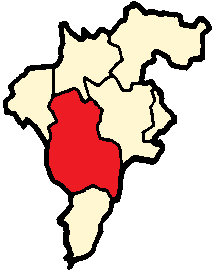
Idrone East is a barony in County Carlow, Ireland. The early barony of Idrone was split into East and West in 1799.

Idrone West is a barony in County Carlow, Ireland. The early barony of Idrone was split into East and West in 1799.

Killeshin Church is a 12th-century Romanesque church and National Monument located in County Laois, Ireland.

Fassadinin, sometimes written Fassadining, is a barony in the north of County Kilkenny, Ireland. It is one of 12 baronies in County Kilkenny. The size of the barony is 276.2 square kilometres (106.6 sq mi). There are 19 civil parishes in Fassadinin. The chief town today is Castlecomer. The N78 Kilkenny/Athy road bisects the barony. Fassadinin is currently administered by Kilkenny County Council.
















